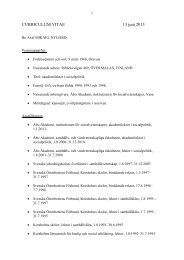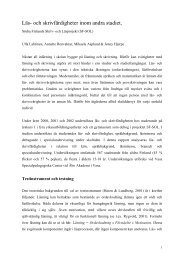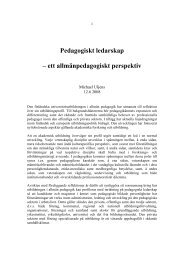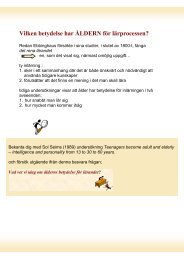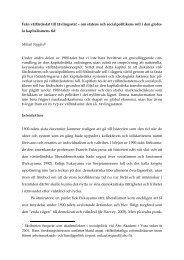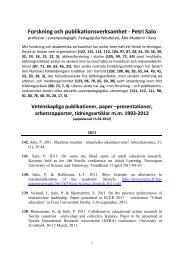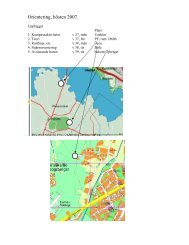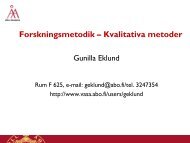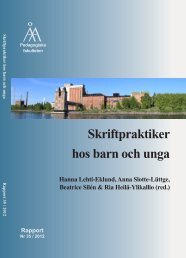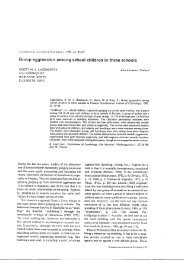34 giorkqvisfpanzees living in the wild, reported warlike c<strong>on</strong>flicts berween groups of chinpanzees,including sysremadc ambush, ending in killings of members of the rival grtup.warfare is, according ro rhe sratemenr, a peculiar hun'ran phenomeno.t that do.snoc occur in other animals. The fact that warfare is frequenr am<strong>on</strong>g humans, thestatement suggesrs, indicares that war is a product of human culture: Language,tools, <strong>and</strong> rechnology have made warfare possible. varfare is, however, nor inevitable;rhere are cultures that have nor engaged in warfare, whereas orher have hadwars fiequenrly. Further, there are cultures which have engaged in warfare frequentlyduring certain periods, although they have been living in peace wirh rheirneighbors at orher times (The seville staremenc <strong>on</strong> Molence, r986ii989).People used to jusrifo slavery <strong>and</strong> sexist dominati<strong>on</strong> by claiming rhat they werebiological <strong>and</strong> inevitable. These claims were found ro be unrrue, slavery was ended,<strong>and</strong> the world communicy is working ro srop racial <strong>and</strong> sexisr dominari<strong>on</strong>. In chesame fashi<strong>on</strong>, the signarories of rhe seville staremenr suggesc, rhe world is nowfooling irself by believing thar war <strong>and</strong> violence cannot be ended because rheyc<strong>on</strong>sdture a parr ofour biological makeup.The seville Statemenr was endorsed by a number of n<strong>on</strong>governmental organrzati<strong>on</strong>s,am<strong>on</strong>g them Unired Nari<strong>on</strong>s'Educati<strong>on</strong>al, sciendfic, <strong>and</strong> cultural organizati<strong>on</strong>(UNESCo). An impressive number of scientific organizari<strong>on</strong>s also haveendorsed the statement, am<strong>on</strong>g them, the American Psychological Associari<strong>on</strong>(APA)' the American Anthropological Associati<strong>on</strong> (AAA), <strong>and</strong> rhe Inrernati<strong>on</strong>alsociery for Research <strong>on</strong> Aggressi<strong>on</strong> (lsRA). The iniriarive ro drafr rhe sevilleStatenrent was, in fact, made by individual ISRA menrbers.The validiry of the seville srateme'r has noc g<strong>on</strong>e unquesti<strong>on</strong>ed, <strong>and</strong>, witnrnISRA, there were debaces about whether the sociery should endorse the sratemenror not.\Uhen the council of Representarives of the ApA vored to endorse rhe Sevillestatement in 1987, the Board of scienrific Affairs emphasized that, in their opini<strong>on</strong>,it is not a quesri<strong>on</strong> of a scienrific sraremenr <strong>on</strong> the issue of specific inheriredbehavioral traits. Rather, it is a social sraremenr designed ro eliminare unfoundedstereorypic thinking <strong>on</strong> the inevirabiliry of war.coNcLUstoNsIn summary aggressi<strong>on</strong> is nor an innate drive (or instinct) per se, funcri<strong>on</strong>ing inaccordance with the reservoir model, like drives to satisfii hunger, rhirsr, <strong>and</strong> ie*.Throughout human evoluti<strong>on</strong>ary history incerpers<strong>on</strong>al "ggr.rrio., may have had,however, a facilitating <strong>and</strong> mediating role in the fulfrllmeniof orher drives, whetherthese are innate or learned, such as territorial <strong>and</strong> hierarchical drives, <strong>and</strong> strugglesfor getting access ro mating partners. Aggressive behavior has cerrainly playJanevoluti<strong>on</strong>ary role for survival, especially when resources have been scarce. Althoughscripts of aggressive behavior are learned, n6s Innsgs-nobody knows how ro fighrwithout training or modeling-it may be argued thar rhe abllicy ro learn aggressi<strong>on</strong>has been useful for survival, <strong>and</strong> narural selecti<strong>on</strong> for rhe ability to get angry whenvital interests are threa[ened may have occurred.
3. lnvevitobillty ot C<strong>on</strong>lllcl Bul Not of Vlolence 35The emod<strong>on</strong> of anger is often a predecessor of aggressive behavior, with angerserving as an invigoracing factor, making aggressive behavior more likely. Angershould definitely not be regarded as unnatural; it is an emoti<strong>on</strong> as natural as anyother. Anger however, does not have !o lead to violence. There is not proof of theexistence of any biological factor making violent soluti<strong>on</strong>s of c<strong>on</strong>flicts inevitable.It is especially important ro keep in mind that forms of aggressive behavior arelearned, not innate. While every child has innate programs for laughing, crying,crawling, <strong>and</strong> walking, there is no innace programming for clenching fists, beacing,kicking, or shooting others. These parrerns or scripts of behavior are learned,especially by watching aggressive models. This learning is more likely to occur in asociery acceptive of <strong>and</strong>, even more likely, in <strong>on</strong>e glorifring aggressi<strong>on</strong>. If modernwarfare is a c<strong>on</strong>sequence ofhuman culture rather than ofhuman nature, perhapsculture is also the best cure against it. As the Seville Scarement put it, che speciesrhat invented warfare should also be capable of invendng peace. What is needed,above all, is a change in the general atdtude rowards violence.REFERENCESBan,lura, A. (1973). Aggressioru- A sxialleaming arol1sis. Englew<strong>on</strong>, R. A. (197i). Hurun Aggress<strong>on</strong>- Ncw York: Plenum.Batcs



